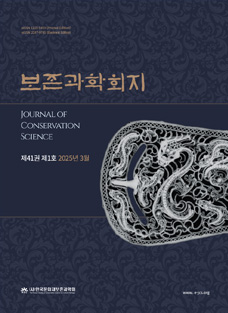Journal of Conservation Science Vol.25 No.1 pp.101-114
영광 군동 마전 원삼국시대 토기와 가마의 제작특성 및 태토의 산지해석
Interpretation of Material Provenance and Production Techniques of Pottery and Kilns from Gundong and Majeon Sites in the 3rd Century at Yeonggwang, Korea
Sung-Yoon Jang,Gi-Gil Lee,Hee-Soo Moon,Chan Hee Lee
Abstract
Potsherds and kilns of the AD 3th century excavated from Gundong and Majeon sites, Korea were studied to investigate the production techniques and provenance of potsherds and kilns on the pastes. For potsherds, kilns blocks and in-situ paleo-soils, provenance of raw materials were estimated through mineralogy and geochemistry, while production technique and thermal feature of kilns were investigated through observation of textures and compositions as well as firing experiment on paleo-soils. As a result of study, potsherds and kilns were found to have similar mineralogical compositions as the neighboring paleo-soils and to have same evolution path with that of geochemistry. The potsherds were divided into 3 groups according to firing temperature and production technique. Group 1 consists of reddish stamped pattern pottery with loose textures, which has many pores and contains many iron oxides. Its temper is less than about 0.5mm, and was probably fired between 700 to 800°C. Group 2 contains ash to grayish blue stamped pattern pottery, which has vitrified texture and few pores. Its temper is less than about 0.5mm, and was probably fired from 900 to 1,000°C. However, some potsherd belongs to the group 2 in terms of features for temper and pastes, but it was probably fired over 1,100°C. Group 3 contains reddish and grayish stamped pattern pottery. It has vitrified matrix, few pores and temper consists of polycrystalline quartz and feldspar over 2mm, and it was probably fired around 1,000°C. The kiln had experienced temperature from 600 to 700°C on the wall, from 900 to 1,000°C on the bottom, suggesting the function of high temperature firing.

 E-Submission
E-Submission 
 E-Submission
E-Submission 
![]() Journal Search Engine
Journal Search Engine




 KSC
KSC